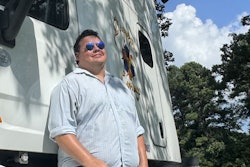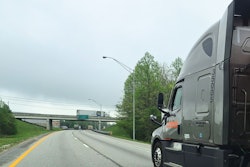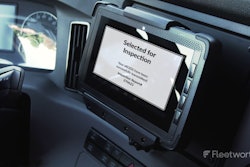The moment of impact. Those white blotches near the horse’s mane are the remnants of a target balloon Dennis Griffin has just hit with his Colt .45 as he piles up points in a cowboy action shooting contest.
When Dennis Griffin steps out of his Kenworth and heads off into the great outdoors, he also steps away from the 21st century and back to a time when America was a frontier society and the West was still wild.
Dressed in the authentic period clothes of a 19th-century cowboy, Griffin pursues a sport he is passionately hooked on, cowboy action shooting, blasting away at targets from the saddle of his horse with smoke and thunder pouring from the barrels of his old-time Colt .45s.
“We’re just a bunch of guys who go riding around playing cowboys and Indians,” says Griffin. “We get dressed up in old-time cowboy gear and go do some barrel racing, pole bending and shooting targets.”
Shooting matches score points at each stage, and each stage is different. In the end the fastest time for the stage wins – with time penalties kicking in for rule infringements like taking the wrong route, missing targets or knocking down poles or barrels.
“I shoot Army Colt .45s at the targets, which are balloons on the top of poles. My guns are third generation weapons, made in the 1970s and exact replicas of an 1873 single action Army colt, built to the same specifications by the same manufacturers, Colt,” Griffin says.
“We shoot blanks, and the balloons are broken by concussion from the explosion of the blank cartridge and also by flame, which you really can’t see in daylight because it’s mostly covered up in smoke, and by some unburnt particles of powder that come out of the barrel. We use black powder, and it’s relatively slow-burning compared to modern-day powders so there are particles left that can hit the balloon. Depending on your aim, lady luck and the wind, you can break a balloon from 10 to 15 feet away.”

Griffin, an owner-operator, drives for CFI, rolling the lower 48 and Canada in a 1997 Kenworth T600, hauling general freight in an air ride, 53-foot van. He was born in New Zealand to an American father and a New Zealand mother, came to America when he was 2 years old and settled in California. At 19 he joined the U.S. Navy, and in his four years in uniform, went through two tours of action in Vietnam.
“I used to shoot when I was a company driver and I could take a little more time off,” Griffin says. “But now I’m an owner-operator, and since I bought my truck I have too many additional bills to pay to take as much time for it as I’d like.”
Griffin first got involved in cowboy action shooting in California in 1985, and he joined the Single Action Shooting Society, the sanctioning body for the sport, in 1990.
“The first competitions I was in you had to shoot from your feet. It was a little like those police school shooting ranges where you walk through town and have to shoot the bad guys but don’t fire at the good guys. My wife also got involved. It was one of those things you could do as a family,” Griffin says.
Griffin shows off the most important aspects of his life – wife Diane, Ms. Poco Flit Bar (“Poco”), an 18-year-old registered quarter horse, and his CFI Kenworth T600.
“My son got into to it, too, and I think it might have helped him. It was something different; it had a whole different set of rules, and it required a whole different kind of self-discipline. Without it maybe he just hangs out at the malls and ice cream stores.”
When Griffin moved to live in Texas in 1990, he says, “someone suggested we start creating matches on horseback, and we worked it out.” He became one of the founders of the Lone Star Frontier Shooting Club, an affiliated club of SASS. “This club is still in existence here in north Texas, and it’s the home of the longest running annual match in the state,” Griffin says.
“I’d worked for the county when I lived in California, but I wanted to get out of the corporate world. I didn’t belong wearing a suit and tie. I really didn’t know what I’d do. Then someone told me, ‘You know, there’s always a need for truck drivers.’ So I tried it. It paid less than I had been making, but it wasn’t a real burden. Now I’m looking at buying more trucks, and I’m going to have someone else earn money for me, too.
In Texas, Griffin became a Rockwall County volunteer deputy sheriff and later joined the Sheriff’s Posse, an all-volunteer force that augments the sheriff’s regular forces in emergencies. CFI, he says, helped by scheduling him at home when duty weeks or training time was scheduled for the Posse.
Griffin says he fits right in at CFI, where jeans and casual shirts are the norm even for management. “CFI is a good place to be,” he says. “They let me do a lot of what I want to do, try to work in with my schedule if I have a match I want to go to. They’re good like that.”
Griffin now sharpens his match skills at home. He has three horses on a small farm, the Lazy Rocking G Ranch in McLendon-Chisolm, Texas.
Cowboy action shooting is not only addictive but also demanding, Griffin says. The sport pushes him to develop new skills and keep setting goals for himself, he says.
But the sport is not just about competition. “I think another great thing about this sport is that it embodies a celebration of so many good things from American history and culture and life. It’s a good, clean-cut wholesome American sport,” Griffin says. “Points scoring is just part of it, but there’s also the feeling you get of knowing what it was like to be a cowboy back in the time when America was young. You’re also keeping some of those traditional old skills and enjoyments alive for new people to come on in and enjoy. It’s keeping part of the Wild West alive.
“You try sitting in period gear in horseback in 100 degrees. You learn something about what it took pioneers in this country to do what they did. Sometimes when I’m driving I-80 across Wyoming for hours and hours, I’ll look and feel that I know something about what it felt like to cross the West in wagons with no roads and maybe making 2 or 3 miles an hour.”
SASS rules for most events require competitors to dress in authentic attire from the late 1800s and use authentic or replica single action revolvers, lever action rifles and old-time shotguns of the period. Even the families and spectators that come to the events are often also authentically dressed in period wear. And many of the larger events offer a taste of the old West with the cooking of traditional cowboy fare.
Cowboy action shooting clubs can be found across the country and in faraway places like Australia, New Zealand, Canada, Norway, the Czech Republic, Spain, Switzerland, Holland and England. If cowboy action shooting appeals to you, you can find out more about it on the Web at www.lsfsc.com (for the Lone Star Shooting Club) or www.sassnet.com (for SASS).
Mark Taylor, independent owner-operator, teaches his 4-year-old son Lee how to shoot straight.
Rods & Barrels
‘I Got It, Daddy!’
At 4 years old, Lee Taylor rides across America in a 2000 Freightliner Classic XL that his dad, Mark, and mom, Renee, drive. In April the family stopped to rest near Globe, Ariz., and Lee climbed out with his toy Winchester.
“Mark got down with him and spent some time teaching him some things about how to aim. Lee said he was duck hunting,” says Renee, who snapped this picture. “I was so thrilled when I got this picture back. It’s one of my favorites of the two of them.”
“Learning to shoot straight can never come too early,” says Mark.
“We’re from deer hunting country in Arkansas, but we’re on the road so much that we do more target shooting than anything else,” says Renee. “But Lee has his little Winchester with him most of the time, and he’s ready to go hunting anything.”
The Taylors are independent owner-operators. Their company, Uglypuppy Exploration, was established in 1999 and is based in Warren, Ark.
“We both drive, and Mark does maintenance and I do the books,” Renee says. “Lee’s been on the road with us since he was 2, and he helps his daddy with the maintenance. He’s even got his own page, ‘Lee Across America,’ on our company Web site [www.uglypuppy.net].
To the hunters featured in Rods & Barrels, Henry Repeating Arms will donate a Henry Golden Boy .22 rifle.
Off-Duty Destinations
Gettysburg National Military Park
It’s July, and America celebrates her independence. But in the small Pennsylvania town of Gettysburg in July of 1863, Americans fought Americans in a battle that was the turning point of the Civil War.
Just 50 miles northwest of Baltimore, the Battle of Gettysburg began on July 1 and ended two days later with the heroic “Pickett’s Charge.” A Union victory for the Army of the Potomac turned back the second invasion of the North by General Robert E. Lee’s Army of Northern Virginia. More than 51,000 soldiers were killed, wounded or captured, making it the bloodiest battle of the Civil War. It was also the last major effort by Lee to take the fighting out of Virginia and into northern states. The Soldiers’ National Cemetery at Gettysburg contains more than 7,000 interments including more than 3,500 from the Civil War.
It was here that President Abraham Lincoln delivered his immortal Gettysburg Address on November 19, 1863.
On February 11, 1895, congress established Gettysburg National Military Park, which is more than 6,000 acres, with 26 miles of park roads and more than 1,400 monuments, markers and memorials.
By the way, if you go, there’s another piece of American history literally right next door.
The farm designated as the Eisenhower National Historic Site is the only place the 34th president of the United States ever called home. In 1950, President Dwight D. Eisenhower and his wife, looking forward to retirement, bought a farm adjoining the Gettysburg National Military Park. The original 189-acre farm was transformed by stages into the President’s 230-acre country estate. During his presidency, the Eisenhowers used the farm as a weekend retreat, a refuge in time of illness and a comfortable meeting place for world leaders. From 1961 to 1969, it was the Eisenhower’s home during a vigorous and active retirement.
How to Get There: From north or south follow US 15 to Gettysburg and watch for signs to direct you to the National Park Service Visitor Center. The visitor center is located between Taneytown Road (State Rt. 134) and Steinwehr Avenue (Bus. Rt. 15). From east or west, drive into Gettysburg on US Rt. 30, turn south on Baltimore Street (Rt. 97) and follow signs to Steinwehr Avenue (Bus. 15). For more information, call (717) 334-1124.









